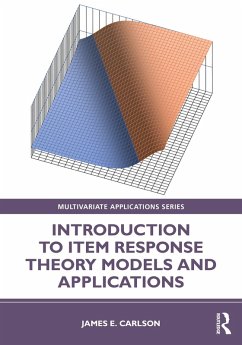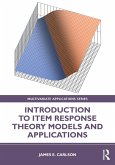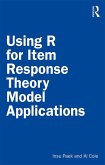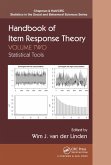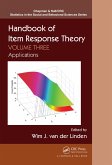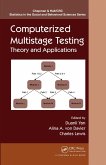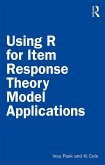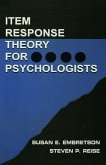Introduction to Item Response Theory Models and Applications (eBook, ePUB)


Alle Infos zum eBook verschenken

Introduction to Item Response Theory Models and Applications (eBook, ePUB)
- Format: ePub
- Merkliste
- Auf die Merkliste
- Bewerten Bewerten
- Teilen
- Produkt teilen
- Produkterinnerung
- Produkterinnerung

Hier können Sie sich einloggen

Bitte loggen Sie sich zunächst in Ihr Kundenkonto ein oder registrieren Sie sich bei bücher.de, um das eBook-Abo tolino select nutzen zu können.
This is a highly accessible, comprehensive introduction to item response theory (IRT) models and their use in various aspects of assessment/testing. The book employs a mixture of graphics and simulated data sets to ease the reader into the material and covers the basics required to obtain a solid grounding in IRT.
Written in an easily accessible way that assumes little mathematical knowledge, Carlson presents detailed descriptions of several commonly used IRT models, including those for items scored on a two-point (dichotomous) scale such as correct/incorrect, and those scored on…mehr
- Geräte: eReader
- mit Kopierschutz
- eBook Hilfe
![Introduction to Item Response Theory Models and Applications (eBook, PDF) Introduction to Item Response Theory Models and Applications (eBook, PDF)]() James CarlsonIntroduction to Item Response Theory Models and Applications (eBook, PDF)61,95 €
James CarlsonIntroduction to Item Response Theory Models and Applications (eBook, PDF)61,95 €![Using R for Item Response Theory Model Applications (eBook, ePUB) Using R for Item Response Theory Model Applications (eBook, ePUB)]() Insu PaekUsing R for Item Response Theory Model Applications (eBook, ePUB)44,95 €
Insu PaekUsing R for Item Response Theory Model Applications (eBook, ePUB)44,95 €![Handbook of Item Response Theory (eBook, ePUB) Handbook of Item Response Theory (eBook, ePUB)]() Handbook of Item Response Theory (eBook, ePUB)63,95 €
Handbook of Item Response Theory (eBook, ePUB)63,95 €![Handbook of Item Response Theory (eBook, ePUB) Handbook of Item Response Theory (eBook, ePUB)]() Handbook of Item Response Theory (eBook, ePUB)63,95 €
Handbook of Item Response Theory (eBook, ePUB)63,95 €![Computerized Multistage Testing (eBook, ePUB) Computerized Multistage Testing (eBook, ePUB)]() Computerized Multistage Testing (eBook, ePUB)45,95 €
Computerized Multistage Testing (eBook, ePUB)45,95 €![Using R for Item Response Theory Model Applications (eBook, PDF) Using R for Item Response Theory Model Applications (eBook, PDF)]() Insu PaekUsing R for Item Response Theory Model Applications (eBook, PDF)44,95 €
Insu PaekUsing R for Item Response Theory Model Applications (eBook, PDF)44,95 €![Item Response Theory for Psychologists (eBook, ePUB) Item Response Theory for Psychologists (eBook, ePUB)]() Susan E. EmbretsonItem Response Theory for Psychologists (eBook, ePUB)61,95 €
Susan E. EmbretsonItem Response Theory for Psychologists (eBook, ePUB)61,95 €-
-
-
Written in an easily accessible way that assumes little mathematical knowledge, Carlson presents detailed descriptions of several commonly used IRT models, including those for items scored on a two-point (dichotomous) scale such as correct/incorrect, and those scored on multiple-point (polytomous) scales, such as degrees of correctness. One chapter describes a model in-depth and is followed by a chapter of instructions and illustrations showing how to apply the models to the reader's own work.
This book is an essential text for instructors and higher level undergraduate and postgraduate students of statistics, psychometrics, and measurement theory across the behavioral and social sciences, as well as testing professionals.
Dieser Download kann aus rechtlichen Gründen nur mit Rechnungsadresse in A, B, BG, CY, CZ, D, DK, EW, E, FIN, F, GR, HR, H, IRL, I, LT, L, LR, M, NL, PL, P, R, S, SLO, SK ausgeliefert werden.
- Produktdetails
- Verlag: Taylor & Francis eBooks
- Seitenzahl: 182
- Erscheinungstermin: 12. Oktober 2020
- Englisch
- ISBN-13: 9781000195385
- Artikelnr.: 60033833
- Verlag: Taylor & Francis eBooks
- Seitenzahl: 182
- Erscheinungstermin: 12. Oktober 2020
- Englisch
- ISBN-13: 9781000195385
- Artikelnr.: 60033833
- Herstellerkennzeichnung Die Herstellerinformationen sind derzeit nicht verfügbar.
1. Background and Terminology
2. Contents of the Following Chapters
2. Models for Dichotomously-Scored Items
1. Introduction
2. Classical Test theory Models
The Model
Item Parameters and their Estimates
Test Parameters and their Estimates
3. Item Response Theory Models
Introduction
The Normal Ogive Three-Parameter Item Response Theory Model
The Three-Parameter Logistic (3PL) Model
Special Cases: The Two-Parameter and One-Parameter Logistic Models
Relationships Between Probabilities of Alternative Responses
Transformations of Scale
Effects of Changes in Parameters
The Test Characteristic Function
The Item Information Function
The Test Information Function and Standard Errors of Measurement
4. IRT Estimation Methodology
Estimation of Item Parameters
Estimation of Proficiency
Indeterminacy of the Scale in IRT Estimation
5. Summary
3. Analyses of Dichotomously-Scored Item and Test Data
1. Introduction
2. Example Classical Test Theory Analyses with a Small Dataset
3. Test and Item Analyses with a Larger Dataset
CTT Item and Test Analysis Results
4. IRT Item and Test Analysis
IRT Software
Missing Data
Iterative Estimation Methodology
Model Fit
5. IRT Analyses Using PARSCALE
PARSCALE Terminology
Some PARSCALE Options
PARSCALE Item Analysis
PARSCALE Test Analyses
6. IRT Analyses Using flexMIRT
flexMIRT Terminology
Some flexMIRT Options
flexMIRT Item Analyses and Comparisons Between Programs
flexMIRT Test Analyses and Comparisons Between Programs
7. Using IRT Results to Evaluate Items and Tests
Evaluating Estimates of Item Parameters
Evaluating Fit of Models to Items
Evaluating Tests as a Whole or Subsets of Test Items
8. Equating, Linking, and Scaling
Equating
Linking
Scaling
Vertical Scaling
9. Summary
4. Models for Polytomously-Scored Items
1. Introduction
2. The Nature of Polytomously-Scored Items
3. Conditional Probability Forms of Models for Polytomous Items
4. Probability-of-Response Form of the Polytomous Models
The 2PPC Model
The GPC Model
The Graded Response (GR) Model
5. Additional Characteristics of the GPC Model
Effects of Changes in Parameters
Alternative Parameterizations
The Expected Score Function
Functions of Scoring at or Above Categories
Comparison of Conditional Response and P+ Functions
Item Mapping and Standard Setting
The Test Characteristic Function
The Item Information Function
The Item Category Information Function
The Test Information Function
Conditional Standard Errors of Measurement
6. Summary
5. Analyses of Polytomously-Scored Item and Test Data
1. Generation of Example Data
2. Classical Test Theory Analyses
Item Analyses
Test Analyses
3. IRT Analyses
PARSCALE Item Analyses
flexMIRT Item Analyses and Comparisons with PARSCALE
4. Additional Methods of Using IRT Results to Evaluate Items
Evaluating Estimates of Item Parameters
Evaluating Fit of Models to Item Data
Additional Graphical Methods
5. Test Analyses
PARSCALE Test Analyses
flexMIRT Test Analyses
6. Placing the Results from Different Analyses on the Same Scale
7. Summary
6. Multidimensional Item Response Theory Models
1. Introduction
2. The Multidimensional 3PL Model for Dichotomous Items
3. The Multidimensional 2PL Model for Dichotomous Items
4. Is there a Multidimensional 1PL Model for Dichotomous Items
5. Further Comments on MIRT Models
Alternate Parameterizations
Additional Analyses of MIRT Data
6. Noncompensatory MIRT Models
7. MIRT Models for Polytomous Data
8. Summary
7. Analyses of Multidimensional Item Response Data
1. Response Data Generation
2. MIRT Computer Software
3. MIRT and Factor analyses
4. flexMIRT analyses of Example Generated Data
One-dimensional Solution with Two-Dimensional Data
Two-dimensional Solution
5. Summary
8. Overview of More Complex Item Response Theory Models
1. Some More Complex Unidimensional Models
Multigroup Models
Adaptive Testing
Mixture Models
Hierarchical Rater Models
Testlet Models
2. More General MIRT Models: Some Further Reading
Hierarchical Models
3. Cognitive Diagnostic Models
4. Summary
References
Appendix A. Some Technical Background
1. Slope of the 3PL Curve at the Inflection Point where
2. Simplifying Notation for GPC Expressions
3. Some Characteristics of GPC Model Items
Peaks of Response Curves
Crossing Point of Pk and Pk-1
Crossing Point of P0 and P2 for m = 3
Symmetry in the Case of m = 3
Limits of the Expected Score Function
Appendix B. Item Category Information Functions
Appendix C. Item Generating Parameters and Classical and IRT Parameter
Estimates
Index
- Introduction
- Background and Terminology
- Contents of the Following Chapters
- Models for Dichotomously-Scored Items
- Introduction
- Classical Test theory Models
- Item Response Theory Models
- IRT Estimation Methodology
- Summary
- Analyses of Dichotomously-Scored Item and Test Data
- Introduction
- Example Classical Test Theory Analyses with a Small Dataset
- Test and Item Analyses with a Larger Dataset
- IRT Item and Test Analysis
- IRT Analyses Using PARSCALE
- IRT Analyses Using flexMIRT
- Using IRT Results to Evaluate Items and Tests
- Equating, Linking, and Scaling
- Summary
- Models for Polytomously-Scored Items
- Introduction
- The Nature of Polytomously-Scored Items
- Conditional Probability Forms of Models for Polytomous Items
- Probability-of-Response Form of the Polytomous Models
- Additional Characteristics of the GPC Model
- Summary
- Analyses of Polytomously-Scored Item and Test Data
- Generation of Example Data
- Classical Test Theory Analyses
- IRT Analyses
- Additional Methods of Using IRT Results to Evaluate Items
- Test Analyses
- Placing the Results from Different Analyses on the Same Scale
- Summary
- Multidimensional Item Response Theory Models
- Introduction
- The Multidimensional 3PL Model for Dichotomous Items
- The Multidimensional 2PL Model for Dichotomous Items
- Is there a Multidimensional 1PL Model for Dichotomous Items
- Further Comments on MIRT Models
- Noncompensatory MIRT Models
- MIRT Models for Polytomous Data
- Summary
- Analyses of Multidimensional Item Response Data
- Response Data Generation
- MIRT Computer Software
- MIRT and Factor analyses
- flexMIRT analyses of Example Generated Data
- Summary
- Overview of More Complex Item Response Theory Models
- Some More Complex Unidimensional Models
- More General MIRT Models: Some Further Reading
- Cognitive Diagnostic Models
- Summary
The Model
Item Parameters and their Estimates
Test Parameters and their Estimates
Introduction
The Normal Ogive Three-Parameter Item Response Theory Model
The Three-Parameter Logistic (3PL) Model
Special Cases: The Two-Parameter and One-Parameter Logistic Models
Relationships Between Probabilities of Alternative Responses
Transformations of Scale
Effects of Changes in Parameters
The Test Characteristic Function
The Item Information Function
The Test Information Function and Standard Errors of Measurement
Estimation of Item Parameters
Estimation of Proficiency
Indeterminacy of the Scale in IRT Estimation
CTT Item and Test Analysis Results
IRT Software
Missing Data
Iterative Estimation Methodology
Model Fit
PARSCALE Terminology
Some PARSCALE Options
PARSCALE Item Analysis
PARSCALE Test Analyses
flexMIRT Terminology
Some flexMIRT Options
flexMIRT Item Analyses and Comparisons Between Programs
flexMIRT Test Analyses and Comparisons Between Programs
Evaluating Estimates of Item Parameters
Evaluating Fit of Models to Items
Evaluating Tests as a Whole or Subsets of Test Items
Equating
Linking
Scaling
Vertical Scaling
The 2PPC Model
The GPC Model
The Graded Response (GR) Model
Effects of Changes in Parameters
Alternative Parameterizations
The Expected Score Function
Functions of Scoring at or Above Categories
Comparison of Conditional Response and P+ Functions
Item Mapping and Standard Setting
The Test Characteristic Function
The Item Information Function
The Item Category Information Function
The Test Information Function
Conditional Standard Errors of Measurement
Item Analyses
Test Analyses
PARSCALE Item Analyses
flexMIRT Item Analyses and Comparisons with PARSCALE
Evaluating Estimates of Item Parameters
Evaluating Fit of Models to Item Data
Additional Graphical Methods
PARSCALE Test Analyses
flexMIRT Test Analyses
Alternate Parameterizations
Additional Analyses of MIRT Data
One-dimensional Solution with Two-Dimensional Data
Two-dimensional Solution
Multigroup Models
Adaptive Testing
Mixture Models
Hierarchical Rater Models
Testlet Models
Hierarchical Models
References
Appendix A. Some Technical Background
1. Slope of the 3PL Curve at the Inflection Point where
2. Simplifying Notation for GPC Expressions
3. Some Characteristics of GPC Model Items
Peaks of Response Curves
Crossing Point of Pk and Pk-1
Crossing Point of P0 and P2 for m = 3
Symmetry in the Case of m = 3
Limits of the Expected Score Function
Appendix B. Item Category Information Functions
Appendix C. Item Generating Parameters and Classical and IRT Parameter Estimates
Index
1. Background and Terminology
2. Contents of the Following Chapters
2. Models for Dichotomously-Scored Items
1. Introduction
2. Classical Test theory Models
The Model
Item Parameters and their Estimates
Test Parameters and their Estimates
3. Item Response Theory Models
Introduction
The Normal Ogive Three-Parameter Item Response Theory Model
The Three-Parameter Logistic (3PL) Model
Special Cases: The Two-Parameter and One-Parameter Logistic Models
Relationships Between Probabilities of Alternative Responses
Transformations of Scale
Effects of Changes in Parameters
The Test Characteristic Function
The Item Information Function
The Test Information Function and Standard Errors of Measurement
4. IRT Estimation Methodology
Estimation of Item Parameters
Estimation of Proficiency
Indeterminacy of the Scale in IRT Estimation
5. Summary
3. Analyses of Dichotomously-Scored Item and Test Data
1. Introduction
2. Example Classical Test Theory Analyses with a Small Dataset
3. Test and Item Analyses with a Larger Dataset
CTT Item and Test Analysis Results
4. IRT Item and Test Analysis
IRT Software
Missing Data
Iterative Estimation Methodology
Model Fit
5. IRT Analyses Using PARSCALE
PARSCALE Terminology
Some PARSCALE Options
PARSCALE Item Analysis
PARSCALE Test Analyses
6. IRT Analyses Using flexMIRT
flexMIRT Terminology
Some flexMIRT Options
flexMIRT Item Analyses and Comparisons Between Programs
flexMIRT Test Analyses and Comparisons Between Programs
7. Using IRT Results to Evaluate Items and Tests
Evaluating Estimates of Item Parameters
Evaluating Fit of Models to Items
Evaluating Tests as a Whole or Subsets of Test Items
8. Equating, Linking, and Scaling
Equating
Linking
Scaling
Vertical Scaling
9. Summary
4. Models for Polytomously-Scored Items
1. Introduction
2. The Nature of Polytomously-Scored Items
3. Conditional Probability Forms of Models for Polytomous Items
4. Probability-of-Response Form of the Polytomous Models
The 2PPC Model
The GPC Model
The Graded Response (GR) Model
5. Additional Characteristics of the GPC Model
Effects of Changes in Parameters
Alternative Parameterizations
The Expected Score Function
Functions of Scoring at or Above Categories
Comparison of Conditional Response and P+ Functions
Item Mapping and Standard Setting
The Test Characteristic Function
The Item Information Function
The Item Category Information Function
The Test Information Function
Conditional Standard Errors of Measurement
6. Summary
5. Analyses of Polytomously-Scored Item and Test Data
1. Generation of Example Data
2. Classical Test Theory Analyses
Item Analyses
Test Analyses
3. IRT Analyses
PARSCALE Item Analyses
flexMIRT Item Analyses and Comparisons with PARSCALE
4. Additional Methods of Using IRT Results to Evaluate Items
Evaluating Estimates of Item Parameters
Evaluating Fit of Models to Item Data
Additional Graphical Methods
5. Test Analyses
PARSCALE Test Analyses
flexMIRT Test Analyses
6. Placing the Results from Different Analyses on the Same Scale
7. Summary
6. Multidimensional Item Response Theory Models
1. Introduction
2. The Multidimensional 3PL Model for Dichotomous Items
3. The Multidimensional 2PL Model for Dichotomous Items
4. Is there a Multidimensional 1PL Model for Dichotomous Items
5. Further Comments on MIRT Models
Alternate Parameterizations
Additional Analyses of MIRT Data
6. Noncompensatory MIRT Models
7. MIRT Models for Polytomous Data
8. Summary
7. Analyses of Multidimensional Item Response Data
1. Response Data Generation
2. MIRT Computer Software
3. MIRT and Factor analyses
4. flexMIRT analyses of Example Generated Data
One-dimensional Solution with Two-Dimensional Data
Two-dimensional Solution
5. Summary
8. Overview of More Complex Item Response Theory Models
1. Some More Complex Unidimensional Models
Multigroup Models
Adaptive Testing
Mixture Models
Hierarchical Rater Models
Testlet Models
2. More General MIRT Models: Some Further Reading
Hierarchical Models
3. Cognitive Diagnostic Models
4. Summary
References
Appendix A. Some Technical Background
1. Slope of the 3PL Curve at the Inflection Point where
2. Simplifying Notation for GPC Expressions
3. Some Characteristics of GPC Model Items
Peaks of Response Curves
Crossing Point of Pk and Pk-1
Crossing Point of P0 and P2 for m = 3
Symmetry in the Case of m = 3
Limits of the Expected Score Function
Appendix B. Item Category Information Functions
Appendix C. Item Generating Parameters and Classical and IRT Parameter
Estimates
Index
- Introduction
- Background and Terminology
- Contents of the Following Chapters
- Models for Dichotomously-Scored Items
- Introduction
- Classical Test theory Models
- Item Response Theory Models
- IRT Estimation Methodology
- Summary
- Analyses of Dichotomously-Scored Item and Test Data
- Introduction
- Example Classical Test Theory Analyses with a Small Dataset
- Test and Item Analyses with a Larger Dataset
- IRT Item and Test Analysis
- IRT Analyses Using PARSCALE
- IRT Analyses Using flexMIRT
- Using IRT Results to Evaluate Items and Tests
- Equating, Linking, and Scaling
- Summary
- Models for Polytomously-Scored Items
- Introduction
- The Nature of Polytomously-Scored Items
- Conditional Probability Forms of Models for Polytomous Items
- Probability-of-Response Form of the Polytomous Models
- Additional Characteristics of the GPC Model
- Summary
- Analyses of Polytomously-Scored Item and Test Data
- Generation of Example Data
- Classical Test Theory Analyses
- IRT Analyses
- Additional Methods of Using IRT Results to Evaluate Items
- Test Analyses
- Placing the Results from Different Analyses on the Same Scale
- Summary
- Multidimensional Item Response Theory Models
- Introduction
- The Multidimensional 3PL Model for Dichotomous Items
- The Multidimensional 2PL Model for Dichotomous Items
- Is there a Multidimensional 1PL Model for Dichotomous Items
- Further Comments on MIRT Models
- Noncompensatory MIRT Models
- MIRT Models for Polytomous Data
- Summary
- Analyses of Multidimensional Item Response Data
- Response Data Generation
- MIRT Computer Software
- MIRT and Factor analyses
- flexMIRT analyses of Example Generated Data
- Summary
- Overview of More Complex Item Response Theory Models
- Some More Complex Unidimensional Models
- More General MIRT Models: Some Further Reading
- Cognitive Diagnostic Models
- Summary
The Model
Item Parameters and their Estimates
Test Parameters and their Estimates
Introduction
The Normal Ogive Three-Parameter Item Response Theory Model
The Three-Parameter Logistic (3PL) Model
Special Cases: The Two-Parameter and One-Parameter Logistic Models
Relationships Between Probabilities of Alternative Responses
Transformations of Scale
Effects of Changes in Parameters
The Test Characteristic Function
The Item Information Function
The Test Information Function and Standard Errors of Measurement
Estimation of Item Parameters
Estimation of Proficiency
Indeterminacy of the Scale in IRT Estimation
CTT Item and Test Analysis Results
IRT Software
Missing Data
Iterative Estimation Methodology
Model Fit
PARSCALE Terminology
Some PARSCALE Options
PARSCALE Item Analysis
PARSCALE Test Analyses
flexMIRT Terminology
Some flexMIRT Options
flexMIRT Item Analyses and Comparisons Between Programs
flexMIRT Test Analyses and Comparisons Between Programs
Evaluating Estimates of Item Parameters
Evaluating Fit of Models to Items
Evaluating Tests as a Whole or Subsets of Test Items
Equating
Linking
Scaling
Vertical Scaling
The 2PPC Model
The GPC Model
The Graded Response (GR) Model
Effects of Changes in Parameters
Alternative Parameterizations
The Expected Score Function
Functions of Scoring at or Above Categories
Comparison of Conditional Response and P+ Functions
Item Mapping and Standard Setting
The Test Characteristic Function
The Item Information Function
The Item Category Information Function
The Test Information Function
Conditional Standard Errors of Measurement
Item Analyses
Test Analyses
PARSCALE Item Analyses
flexMIRT Item Analyses and Comparisons with PARSCALE
Evaluating Estimates of Item Parameters
Evaluating Fit of Models to Item Data
Additional Graphical Methods
PARSCALE Test Analyses
flexMIRT Test Analyses
Alternate Parameterizations
Additional Analyses of MIRT Data
One-dimensional Solution with Two-Dimensional Data
Two-dimensional Solution
Multigroup Models
Adaptive Testing
Mixture Models
Hierarchical Rater Models
Testlet Models
Hierarchical Models
References
Appendix A. Some Technical Background
1. Slope of the 3PL Curve at the Inflection Point where
2. Simplifying Notation for GPC Expressions
3. Some Characteristics of GPC Model Items
Peaks of Response Curves
Crossing Point of Pk and Pk-1
Crossing Point of P0 and P2 for m = 3
Symmetry in the Case of m = 3
Limits of the Expected Score Function
Appendix B. Item Category Information Functions
Appendix C. Item Generating Parameters and Classical and IRT Parameter Estimates
Index
